The pictures we use in our articles might not show exactly what the words say. We choose these pictures to make you interested in reading more. The pictures work together with the words but don’t take their place. The words still tell you the important facts.
Are you ready to embark on an exciting journey through the enchanting realm of planetary volcanoes? These captivating natural wonders have not only fascinated scientists and astronomy enthusiasts for centuries but also offer a window into the dynamic geology of distant worlds. From the fiery eruptions on Jupiter's moon Io to the frozen cryovolcanoes on Saturn's moon Enceladus, planetary volcanoes showcase the diverse and awe-inspiring landscapes of our solar system.
Discovering the Marvels of Planetary Volcanoes
Planetary Volcanoes: Beyond Earth’s Boundaries
Did you know that planetary volcanoes are not unique to Earth? These mesmerizing geological features can be found on various celestial bodies within our solar system, including Mars, Venus, and even Jupiter's volcanic moon Io. This highlights the dynamic nature of the universe and the incredible geological processes that shape planets and moons alike.
Olympus Mons: The Giant of the Solar System
One of the most remarkable planetary volcanoes is Olympus Mons, standing tall on the surface of Mars. With a height of 13.6 miles (22 kilometers), Olympus Mons is not only the largest volcano on Mars but also the tallest in the entire solar system. To put it into perspective, this colossal volcano is around three times taller than Mount Everest, Earth's highest peak.
Cryovolcanism: Icy Eruptions in Space
While we often associate volcanoes with hot lava and molten rock, cryovolcanism introduces a unique twist to volcanic activity. This phenomenon occurs on icy moons like Enceladus, where geysers of water vapor and ice particles erupt from cracks in the frozen surface. These cryovolcanoes offer valuable insights into the intricate interactions between water, ice, and the internal processes of moons in our solar system.
Io: The Planet with a Fiery Heart
With over 400 active volcanoes, Jupiter's moon Io holds the record for being the most volcanically active body in our solar system. The intense tidal forces exerted by Jupiter's gravity lead to frequent volcanic eruptions, with volcanic plumes reaching astonishing heights of up to 190 miles (300 kilometers). The molten sulfur and lava ejected into space paint a mesmerizing yet intense picture of volcanic activity on Io.
Delving Into the Impact of Planetary Volcanoes
Shaping Planetary Atmospheres
Volcanic activity plays a crucial role in shaping the atmospheres of planets and moons. Gases released during volcanic emissions, such as carbon dioxide, sulfur dioxide, and water vapor, contribute to the formation or modification of atmospheres. Venus, for example, boasts a dense and toxic atmosphere predominantly shaped by volcanic activity.
Temporary Global Cooling: The Volcanic Winter Effect
Massive volcanic eruptions on Earth, like the 1815 eruption of Mount Tambora, can trigger temporary global cooling. The release of volcanic ash and aerosols into the atmosphere reflects sunlight back into space, resulting in a cooling effect known as volcanic winter. This phenomenon can lead to significant climate disruptions and decreased agricultural productivity.
Geological Masterpieces: Unique Formations by Volcanic Activity
Planetary volcanoes possess the power to sculpt the surface of celestial bodies, creating extraordinary geological formations. Valles Marineris on Mars, a colossal system of canyons stretching over 2,500 miles (4,000 kilometers) in length and up to 6 miles (10 kilometers) deep, stands as a testament to the transformative force of tectonic and volcanic processes.
The Role in Habitability: A Double-Edged Sword
The presence of volcanic activity can have both positive and negative implications for the potential habitability of a planet or moon. While volcanic regions can offer essential elements and energy sources supportive of microbial life, they can also release toxic gases and create inhospitable conditions. Understanding the impact of volcanic activity is crucial in the search for extraterrestrial life.
Unveiling the Secrets and Significance of Planetary Volcanoes
In conclusion, the exploration of planetary volcanoes unveils a thrilling world of geological wonders and scientific discovery. From the majestic peaks of Olympus Mons to the erupting plumes on Jupiter's moon Io, these volcanic features showcase the dynamic and ever-changing nature of the universe. By studying planetary volcanoes, scientists gain valuable insights into the geological processes and history of other worlds, enriching our understanding of planetary evolution and potential habitats for life beyond Earth.
FAQs: Your Gateway to Planetary Volcano Knowledge
- What is a planetary volcano?
A planetary volcano is a volcano that occurs on celestial bodies other than Earth, such as moons, planets, or dwarf planets, exhibiting similar or distinct characteristics compared to Earth's volcanoes.
- How do planetary volcanoes form?
Planetary volcanoes form through various processes, including the eruption of molten rock or the release of volatile substances like water or sulfur dioxide, influenced by the composition and geological activity of the celestial body.
- Are there active volcanoes in our solar system?
Yes, active volcanoes exist in our solar system, with Jupiter's moon Io renowned for its intense volcanic activity, while bodies like Enceladus demonstrate cryovolcanism through icy eruptions.
- Can planetary volcanoes support life?
While challenging for life as we know it, volcanic regions near planetary volcanoes may provide environments conducive to microbial life, offering heat, energy sources, and nutrient-rich materials.
- How do scientists study planetary volcanoes?
Scientists employ spacecraft missions, remote sensing techniques, and computer simulations to study planetary volcanoes, with missions like Voyager, Galileo, and Cassini-Huygens yielding valuable data and images.
- How does studying planetary volcanoes benefit us?
Studying planetary volcanoes enhances our understanding of geological processes, history, and dynamics on other celestial bodies, aiding in the search for potential habitats for extraterrestrial life and enriching our knowledge of planetary formation and evolution.
Embark on a Journey of Wonder and Discovery
As you venture into the realm of planetary volcanoes, let your curiosity guide you through the mysteries of space and the geological marvels that define our solar system. From the towering heights of Olympus Mons to the icy eruptions of cryovolcanoes, each discovery unravels the complex tapestry of planetary geology and ignites a sense of wonder and awe. Join us in exploring the captivating world of planetary volcanoes—a journey that promises to enlighten, inspire, and spark the imagination of the explorer within you.






